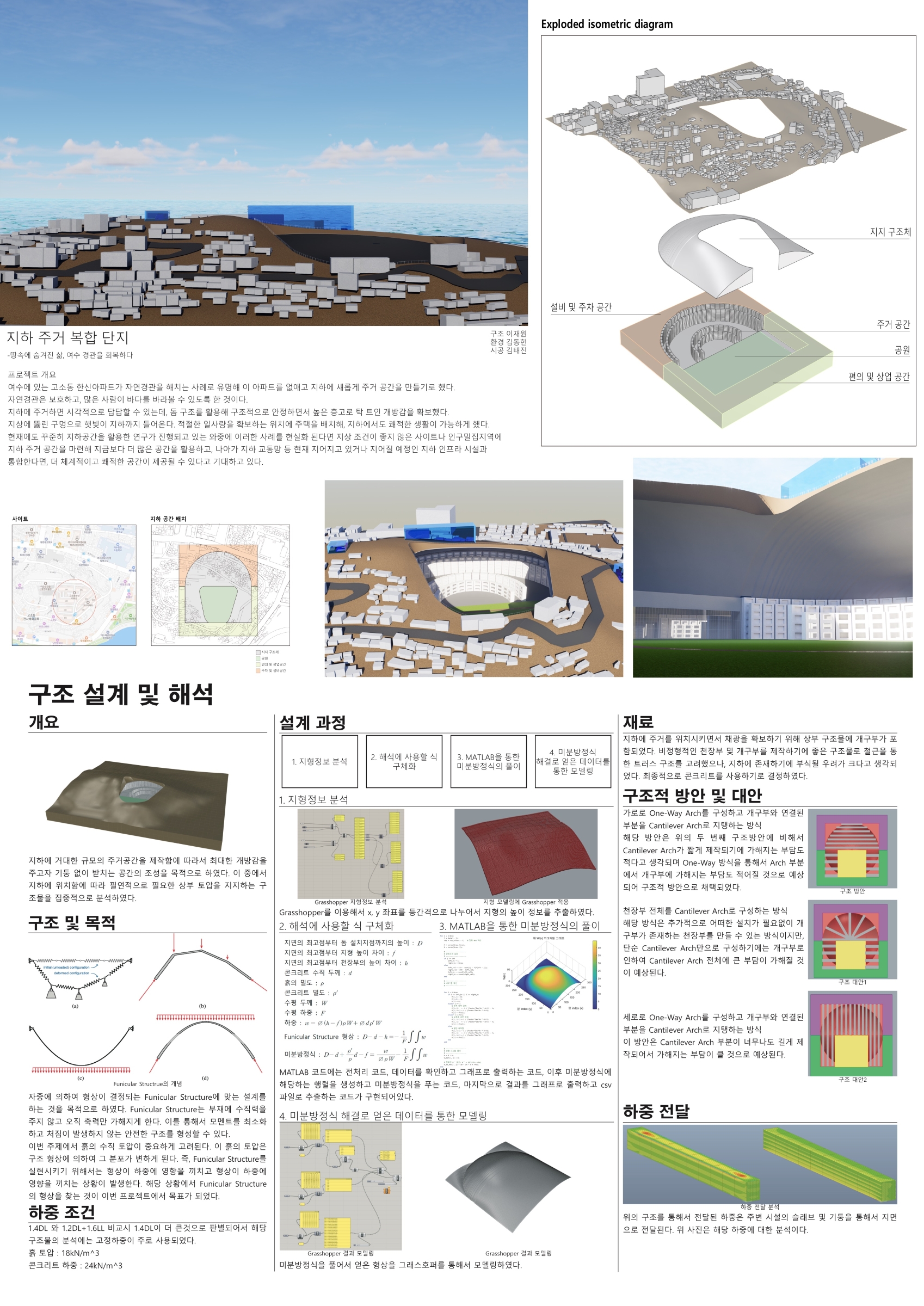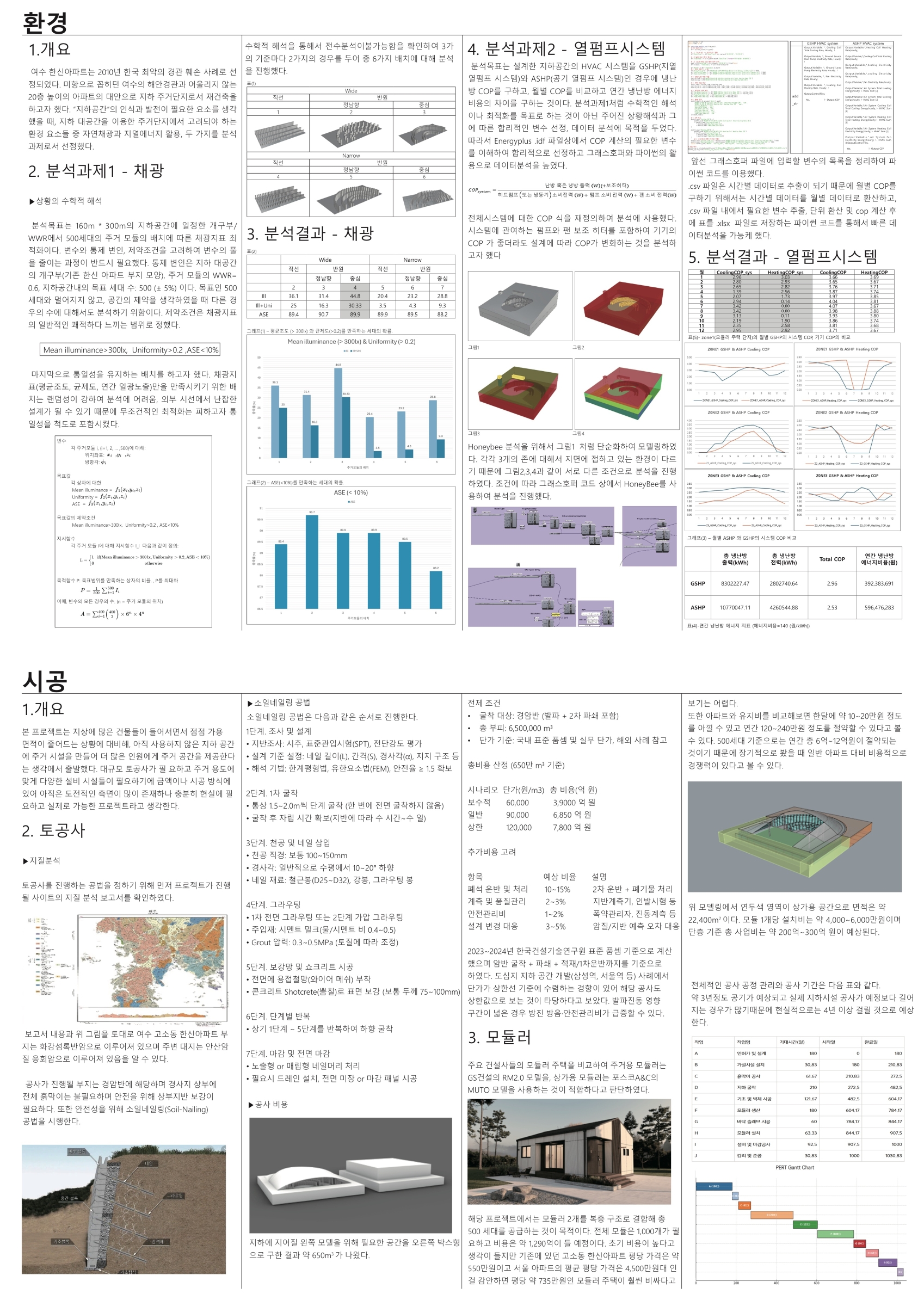세대차이 (이재원, 김태진, 김동현) _ 지하주거복합단지
본 프로젝트는 지상의 가용 면적이 점차 줄어드는 도시환경에서 새로운 주거 대안을 모색하는 과정에서 출발했습니다. 아직 활용되지 않은 지하 공간을 주거지로 전환함으로써, 더 많은 인원에게 안정적인 주거를 제공할 수 있다는 가능성에 주목하였습니다.
지하 주거의 단점은 분명 존재하지만, 지열에너지를 활용한 에너지 절감, 풍하중으로부터의 자유, 구조적 안정성 등의 장점을 바탕으로 이를 충분히 상쇄할 수 있다고 판단했습니다. 특히 돔 구조를 적용하여 높은 층고를 확보함으로써, 지하 특유의 폐쇄감을 줄이고 개방감을 극대화했습니다. 또한, 채광용 개구부를 지상에 설치하여 햇빛이 지하까지 들어올 수 있도록 설계하고, 일사량 분석을 통해 주택 배치를 최적화함으로써 쾌적한 거주 환경을 조성했습니다.
입지로는 여수 고소동 한신아파트 부지를 선정했습니다. 해당 아파트는 바다 조망을 막아 자연경관을 해치는 사례로 비판을 받아왔으며, 이를 철거하고 지하에 새로운 주거지를 조성함으로써 자연환경 보존과 주거 확보라는 두 가지 목표를 동시에 달성하고자 했습니다. 기존보다 많은 500세대 규모의 모듈러 주택을 공급함으로써 공급 효율성을 높이고, 모듈러 특유의 유지비 절감 효과를 통해 기존 아파트 대비 경제적 경쟁력도 확보하였습니다.
또한 지상에는 바다 조망이 가능한 커뮤니티 시설을 설치하여 기존의 오션뷰를 보존하고, 누구나 해양 경관을 즐길 수 있도록 설계했습니다. 주거 외에도 상가, 주차장, 공원 등 다양한 편의시설을 지하에 통합 배치하여 거주 편의성을 확보하고, 지하에서도 자연과의 연결감을 유지할 수 있도록 고려했습니다.
이러한 시도는 인구 밀집 지역, 지상 여건이 불리한 부지, 또는 지하 인프라와 연계 가능한 장소에서 폭넓게 응용 가능하며, 지하 교통망 및 인프라 개발과의 연계를 통해 보다 체계적이고 지속가능한 도시 주거의 대안을 제시할 수 있을 것입니다.
This project originated from the idea that, as developable land on the surface continues to diminish due to increasing urban density, utilizing the unused underground space could offer a new solution for providing housing to a larger population.
While underground living presents certain challenges, we believe these can be sufficiently mitigated by its advantages—such as reduced energy consumption through geothermal heating, freedom from wind loads, and increased structural stability. By applying a dome structure, we ensured high ceilings and an open atmosphere, helping to counteract the sense of confinement often associated with subterranean spaces. Furthermore, openings at the surface allow natural light to penetrate underground, and housing units are strategically positioned based on solar access analysis, enabling a bright and pleasant living environment.
The chosen site is the location of the Hanshin Apartment complex in Goso-dong, Yeosu, which is often cited as a negative example of development that obstructs natural ocean views. By removing the existing complex and placing the new residential space underground, the project aims to preserve the coastal landscape while also expanding housing supply. A total of 500 modular housing units—more than the current number—will be installed, utilizing efficient modular construction methods that significantly reduce maintenance costs and enhance affordability compared to traditional apartment buildings.
To address potential dissatisfaction from residents who previously enjoyed ocean views, we designed community facilities on the surface that allow unobstructed sea views for all, while maintaining the integrity of the natural scenery. Additionally, the underground space incorporates not only residences but also essential amenities such as retail spaces, parking facilities, and a park, making it convenient and livable without the need to frequently access the surface. The underground park offers opportunities for leisure and walking, helping to minimize discomfort often associated with below-ground living.
At a time when research on underground space utilization is actively underway, this project provides a tangible model that, if realized, could be applied to high-density urban areas or sites with unfavorable surface conditions. Moreover, integration with existing and future underground infrastructure—such as transit networks—would enable a more efficient and sustainable urban environment.

